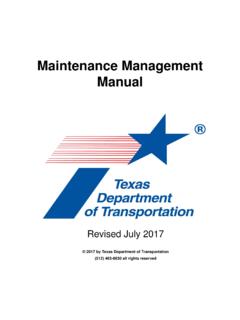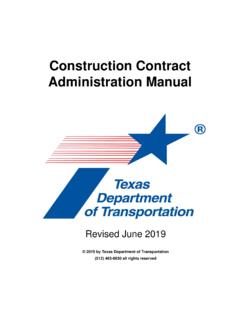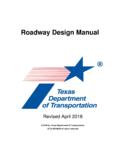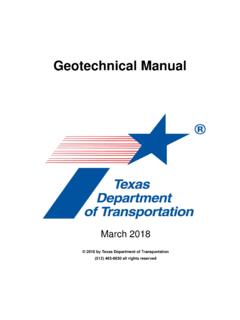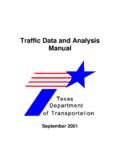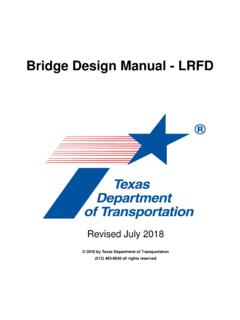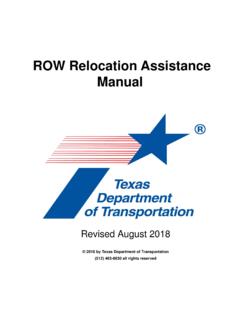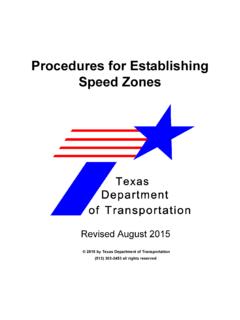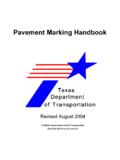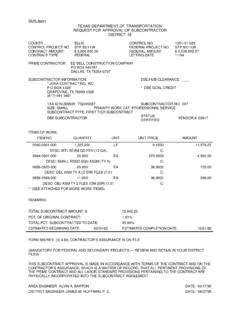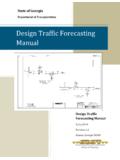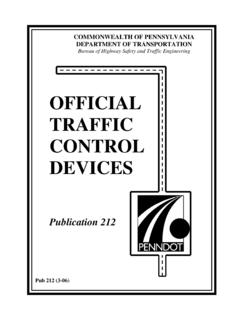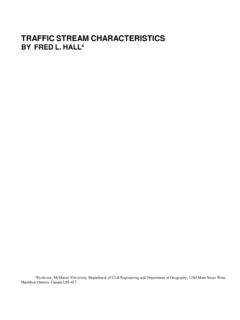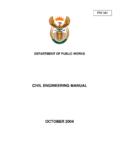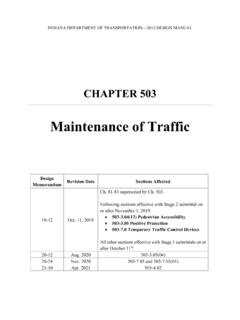Transcription of Access Management Manual
1 Access Management ManualJuly 2011 2011 by Texas Department of Transportation(512) 302-2453 all rights reservedManual Notice 2011-1 From:Mark A Marek, : Access Management ManualEffective Date:July 01, 2011 PurposeThis revision is intended to update the Access Management Manual , specifically to include a note to users that recent changes to Chapter 21 of the Texas Property Code and Chapter 2206 of the Texas Government Code, regarding the compensation of buying and selling of Access to abutting property owners along state highways, may not be reflected in the Manual . These changes will be included in the next revision of the Manual estimated to be released by early Fall questions concerning the information contained in the Manual to the Roadway Design Sec-tion in the Design NoticeThis Access Management Manual and all future revisions: Copyright 2011 by Texas Department of Transportation (TxDOT).
2 Published by the Design Division (DES). All rights Manual notices are available in a PDF Management Manuali TxDOT 07/2011 Table of ContentsChapter 1 Access Management GeneralSection 1 Introduction..1-2 Non-discrimination ..1-2 Applicability ..1-2 Overview ..1-2 Section 2 The Benefits of Access Management ..1-4 Overview ..1-4 Effects on Safety ..1-4 Operational Effects ..1-6 Economic Effects ..1-8 Chapter 2 Access Management StandardsSection 1 Application of Access Standards ..2-2 Section 2 Definitions ..2-3 Section 3 Number, Location, and Spacing of Access Connections ..2-7 Overview ..2-7 New Highways on New Alignments (New Location) ..2-8 Freeway Mainlanes ..2-8 Emergency Access ..2-15 Field Driveways ..2-15 Section 4 Driveway Permits, Design, and Materials ..2-16 Overview ..2-16 Permits..2-16 Driveway Design..2-17 Drainage ..2-18 Materials.
3 2-19 Section 5 Variance Process..2-20 Chapter 3 Administrative ProceduresSection 1 Approval Process for Local Guidelines ..3-2 Overview ..3-2 Application Local Access Management Plans (TxDOT as Permitting Authority) ..3-2 Application Local Access Management Plans (Municipality as Permitting Authority) ..3-2 Assumption of Permitting Function Optional ..3-3 Engineering Access Locations ..3-3 Deviation Process (Municipality as Permitting Authority)..3-3 Submission of Local Access Management Plans ..3-3 Access Management Manualii TxDOT 07/2011 Section 2 Corridor Access Management Plans..3-4 Overview ..3-4 Functional Criteria..3-4 Section 3 Engineering Analysis ..3-5 Overview ..3-5 Early Coordination ..3-5 Concurrence with Local Guidelines ..3-5 Questions to Consider ..3-5 Engineering Study versus traffic Impact Analysis (TIA) ..3-6 Section 4 Sale of TxDOT Controlled Access .
4 3-9 Section 5 Appeal Process ..3-10 Appeal Process (TxDOT as Permitting Authority) ..3-10 Data Requirements for an Appeal to Design Division ..3-10 Access Management Manual1-1 TxDOT 07/2011 Chapter 1 Access Management GeneralContents:Section 1 IntroductionSection 2 The Benefits of Access ManagementAccess Management Manual1-2 TxDOT 07/2011 Chapter 1 Access Management GeneralSection 1 IntroductionSection 1 IntroductionNOTE:The information contained in this Manual is in the process of being updated to reflect recent changes to Chapter 21 of the Texas Property Code and Chapter 2206 of the Texas Government Code, and may not accurately reflect current law or depart-ment procedures. Please contact the Design Division at 512-416-2678 for more policy is to ensure that no person in the United States of America shall on the grounds of race, color, national origin, sex, age or disability be excluded from the participation in, be denied the benefits of or otherwise be subjected to discrimination under any of our programs or Access Management criteria contained in this Manual are applicable to all classes of state high-ways.
5 This Manual also provides a mechanism for municipalities to be granted permitting authority to the state highway system. Municipalities that choose to handle Access permitting for state high-way system roadways within their jurisdiction can either develop their own Access Management guidelines or they can adopt the guidelines contained in this Manual . Because they have authority to implement subdivision and zoning regulations, municipalities also have the ability to apply a host of Access man-agement techniques: shared Access , cross Access , lot width requirements, driveway throat length, internal street circulation, and general thoroughfare planning. It is through a cooperative relation-ship between the Department and municipalities that the safety and operational benefits of Access Management can be fully realized. The following subsection provides an overview of Access man-agement and discusses some of its Access Management assists in protecting the substantial public investment in transportation by preserving roadway efficiency and enhancing traffic safety, thus reducing the need for expensive improvements.
6 Furthermore, Access Management can significantly reduce traffic accidents, per-sonal injury, and property damage. To appreciate how Access Management fits into the entire spectrum of the roadway network, one should understand that freeways, arterials, collectors, and local streets serve varying levels of through- traffic movement and Access to property (see Figure 1-1). Access Management Manual1-3 TxDOT 07/2011 Chapter 1 Access Management GeneralSection 1 Introduction Freeways - provide the highest level of mobility and are intended to carry the greatest amount of traffic at the highest speeds. Accordingly, freeway mainlanes provide no direct Access to property and Access to the freeway mainlanes is provided only at interchanges and ramps. Arterials - provide the next highest level of mobility and are intended to carry substantial amounts of traffic over relatively long distances and at relatively high speeds.
7 Direct property Access may be provided but must be carefully managed to preserve arterial mobility and avoid creating unsafe and congested traffic operations. Collectors - provide lower mobility and are intended to carry lower volumes of traffic at lower speeds. Since most of the trips on collectors are shorter distance local trips, these streets can safely provide a higher amount of property Access . Local streets - provide the lowest level of mobility and are intended to provide direct Access to properties, preserve the neighborhood environment, and enhance pedestrian and bicycle 1-1. Access Function 11. TRB Committee on Access Management , Access Management Manual , Transportation Research Board, Washington, , Management Manual1-4 TxDOT 07/2011 Chapter 1 Access Management GeneralSection 2 The Benefits of Access ManagementSection 2 The Benefits of Access ManagementOverviewBelow are some of the benefits that have been realized in communities with effective Access man-agement policies.
8 Delaying or preventing costly highway improvements, Improving roadway safety conditions (reduced crash rates), Reducing traffic delay and congestion, which has a positive economic effect on market areas (as seen in Figure 1-4), Promoting properly designed Access and circulation systems for development, Improving the appearance of transportation corridors and increasing the area available for landscaping, which can help attract investment and enhance the image of an area, Providing property owners and customers with safe Access to roadways, Reducing air pollution, and Making pedestrian and bicycle travel significant benefit is that Access Management requires a more coordinated, long-term approach to land use and transportation; therefore, effective Access Management promotes inter-governmental cooperation relating to land development and transportation on SafetyMore than four decades of research conducted throughout the United States have shown that Access Management improves roadway safety.
9 These safety benefits are attributable to improved Access design, fewer traffic conflict locations, and higher driver response time to potential conflicts. Some key findings on the impacts of arterial Access Management on safety are summarized below. As Access density increases, crash rates increase. Relative increases in crash rates are remarkably consistent among the various studies. Figure 1-2 shows composite crash rate indi-ces derived from the analysis of 37,500 crashes, as compared with a synthesis of previous studies1. The indices were developed by correlating crash rates with Access density - using the crash rates for 10 Access points per mile as a base and then averaging crash rates for each Access density. For example, these indices suggest that an increase from 10 Access points to 20 Access points per mile would increase crash rates by roughly 30 Gluck, J.
10 , Levinson and Stover, NCHRP Report 420: Impacts of Access Management Techniques, National Cooperative Highway Research Program, Transportation Research Board, Washington, , National Academy Press, Management Manual1-5 TxDOT 07/2011 Chapter 1 Access Management GeneralSection 2 The Benefits of Access ManagementFigure 1-2. Composite Crash Rates Roadways with nontraversable medians are safer at higher speeds and at higher traffic volumes than undivided roadways or those with continuous two-way left-turn lanes (TWLTL). Numerous studies from across the nation have been conducted relating to undi-vided, TWLTL, and divided roadways with a nontraversable median. Based on studies, it can be concluded that roadways with a nontraversable median have an average crash rate about 30 percent less than roadways with a TWLTL. Table 1-1 summarizes the representative crash rates by median type for urbanized areas.
